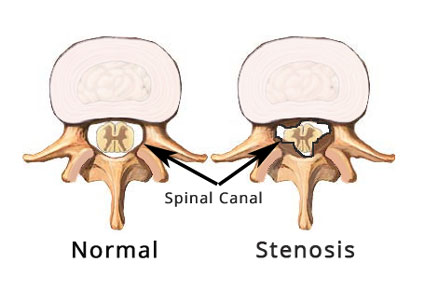What Is Spinal Stenosis and What Causes It?
 Spinal stenosis is a condition in which the spinal canal narrows and compresses the spinal cord or nerve roots. This leads to symptoms such as pain, numbness, or weakness in the back, legs, or arms.
Spinal stenosis is a condition in which the spinal canal narrows and compresses the spinal cord or nerve roots. This leads to symptoms such as pain, numbness, or weakness in the back, legs, or arms.
The narrowing of the spinal canal can be caused by a variety of factors, including:
- Osteoarthritis: A common form of arthritis that causes the breakdown of the cartilage that cushions the joints.
- Herniated discs: A condition where the soft, jelly-like material inside a spinal disc leaks out and compresses the spinal cord or nerve roots.
- Bone spurs: Bony growths that can develop on the vertebrae and compress the spinal cord or nerve roots.
- Tumors: Abnormal growths that can compress the spinal cord or nerve roots.
- Thickened ligaments: Ligaments that support the spine can become thickened over time and compress the spinal cord or nerve roots.
Spinal stenosis is more common in older adults, and symptoms may worsen over time. Other risk factors include a history of spinal injuries or surgeries, genetic predisposition, and certain medical conditions such as scoliosis or Paget’s disease of bone.
Will spinal stenosis heal on its own?
Spinal stenosis is a chronic condition that does not typically heal on its own. However, the severity of the symptoms can vary depending on the extent of the stenosis and the individual’s overall health.
In some cases, the symptoms of spinal stenosis may be mild or intermittent, and individuals may be able to manage them with conservative treatments such as rest, physical therapy, and medication. However, if the stenosis is severe or progressive, surgery may be necessary to relieve pressure on the spinal cord or nerve roots.
It’s important to work with a qualified healthcare provider to determine the best course of treatment for your specific condition.
How is spinal stenosis treated?
The treatment depends on the severity of the condition, the specific symptoms, and the individual’s overall health.
Conservative treatments, which are typically used as a first-line treatment for mild to moderate spinal stenosis, may include:
- Physical therapy (exercises and stretches to improve strength, flexibility, and balance) which can help alleviate symptoms and prevent further spinal stenosis.
- Pain medication, over-the-counter pain relievers like acetaminophen or nonsteroidal anti-inflammatory drugs (NSAIDs) can be used to manage pain and inflammation.
Other treatments include:
- Steroid injections: An injection of a corticosteroid medication into the affected area can help reduce inflammation and pain.
- Surgery: Surgery may be necessary for more severe cases of spinal stenosis, or for those who do not experience relief with conservative treatments.
It’s important to work with a qualified healthcare provider to determine the best course of treatment for your specific condition.
